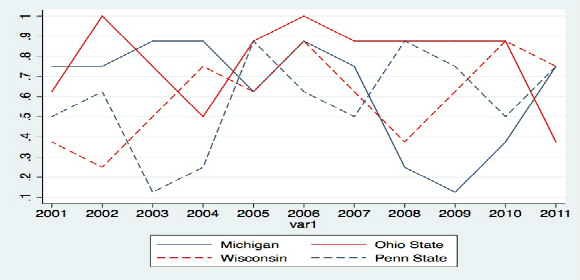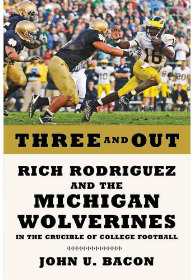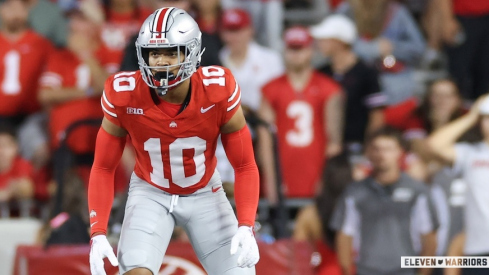
Over the last two weeks I've explored how we might model the rise and decline of college football programs over time and how programs can get back to "great power" status.
I found that winning the last few games of the previous year, bringing in a single dominant offensive player, and getting a new head coach greatly increases a team's likelihood of drastic improvements.
This week I'll conclude my power cycle theory-based mini series by examining how programs fall in to decline.
The past decade has seen some prominent traditional powers fall into multi-year power troughs, including Florida, Texas, Georgia, USC, and Michigan. What precipitated these lulls in prominence? What, if any, indicators could predicted these sharp declines?
The key question for us is whether Ohio State is in for a similar decline, or whether 6-7 can be a single-year blip. Based on multiple simulations (5-7, really??) of Urban's first year, the Buckeye fanbase is in for much wailing and gnashing of teeth.
While each case is certainly different and there are potentially many confounding variables at work, we might be able to generate some hypotheses based on previous cases in the Big Ten.
The Power Curves
I'll be conducting this analysis similarly to last week's, using the above graph of the rise and decline of the major B1G powers.
I consider these four programs' conferences winning percentages for two reasons: 1. It holds the strength of schedules relatively constant and 2. Conference winning percentages are a better measure of relative strength, because there is a constant number of conference games and each win necessitate a loss from another Big Ten team.
Because we're using the same curves as last week, I won't go in to too much detail about the curves themselves again.
However, a few important features: Ohio State was remarkably consistent throught Tress's tenure, particularly from 2005 to 2010. Tressel had really nailed how to win in conference during the latter half of the decade.
The final Carr years at UM were fairly constant as well, though the Rich Rod Experiment (which would be a great band name) didn't help conference win totals (no need to beat a dead horse about that, though).
Penn State and Wisconsin had similarly-shaped curves, with peaks every 2-3 years or so.
How programs fall
 Read and be thankful
Read and be thankfulThe big four teams in the Big Ten have been remarkably stable throughout the past decade, generally only varying from "decent" to "great."
There are two notable exceptions: Penn State's "Dark Years" from 2002-2004 and Michigan from 2008-2010.
There were several other minor declines, including Wisconsin in 2007 and 2008, Penn State in 2006 and 2007, and Ohio State in 2003 and 2004, but Penn State's "Dark Years" and Michigan's defense-less years stand out as being long (three year) declines. Three years of mediocrity (or worse) is fundamentally different than a single rebuilding year.
1. Get a new coach
You might remember that this was also on last week's list. It seems that hiring a new coach is risky business - it can either produce fantastic first or second-year results (Tressel, Meyer, Saban, Chizik, etc) or it can be a failed experiment entirely (Rodriguez, Weis).
I believe we can explain a lot of the variation in outcomes by looking at two factors: 1. the implementation of a new offensive system vs. current personnel and 2. how well the athletic department staff and community embrace the new coach.
The fantastic Three and Out (and M Man's review) details exactly how these two variables started Rodriguez with a systemic disadvantage: he had skill players from the Carr years (those that didn't transfer) and lacked full support from the AD's office.
It's important to note that there does seem to be a tendency for coaches who have been "tenured" at the same school for a long period of time to stagnate. Success breeds a love for the status quo - if a coach was successful early on in his career - and he must have been in order to keep his job - it is likely he will be resistant to change.
Take a look at Mack Brown's Texas in recent years, Paterno's Penn State teams for the last decade, or Mark Richt's program since 2005 - all fairly good, but never great teams. Sometimes ADs and fanbases just want change - even with the risk it entails.
2. Lose starting rb, qb, or majority of ol
I think we don't have quite enough evidence to build a "star player" theory of college football, but it is amazing what a single prolific player can do for a team.
When Penn State entered into the Dark Years in 2003, they had just lost all-everything back Larry Johnson to the NFL as well as four offensive linemen. It doesn't take Football Outsiders to tell you that that doesn't bode well.
Similarly, when Rodriguez took over in 2008, Chad Henne and Mike Hart had just left for the NFL and 5-star Ryan Mallett had transferred. Sure, they wouldn't have worked well in Rich Rod's offense, but their 2008 depth chart at quarterback looks like a wasteland.
You can pretty much guarantee that any year starting a new quarterback, unless he's been in the system for a while (or is named Cam Newton), will be a rebuilding year. Sure, the past three BCS bowls have been won by first-year quarterbacks, but McElroy was a redshirt junior and McCarron was a redshirt sophomore.
So, redshirt your quarterbacks or have one waiting in the wings.
3. recruit poorly
Want to know why Urban spends so much time and energy recruiting? Because it matters.
Sure, 5-star recruits don't always pan out. And yes, I know the list of three star recruits at Ohio State who have become All-Americans, but generally recruiting rankings are helpful. Take a look at Penn State's classes in 2003 - only 11 players and 93rd in the country according to Rivals in '03.
Similarly, Michigan had problems with keeping their recruits during the Rich Rod era, with attrition and transfers at all time highs.
what it means for ohio state
In summary, programs experience multiple years of decline for the reasons you might imagine - no offense, poor recruiting classes, and a lack of support for new coaches. Stagnant tenured coaches don't help either.
The good news is that Ohio State doesn't have any of these warning signs - the community and athletic department love Urban, he has a 5-star quarterback, and his recruiting classes are out of this world. I'm not predicting 12-0, but there is every indication that next year will be far better for Ohio State.

